Weekly Current Affairs (1st to 7th May 2025) - 1 | Weekly Current Affairs - UPSC PDF Download
Supreme Court Ruling on Digital Access for Persons with Disabilities
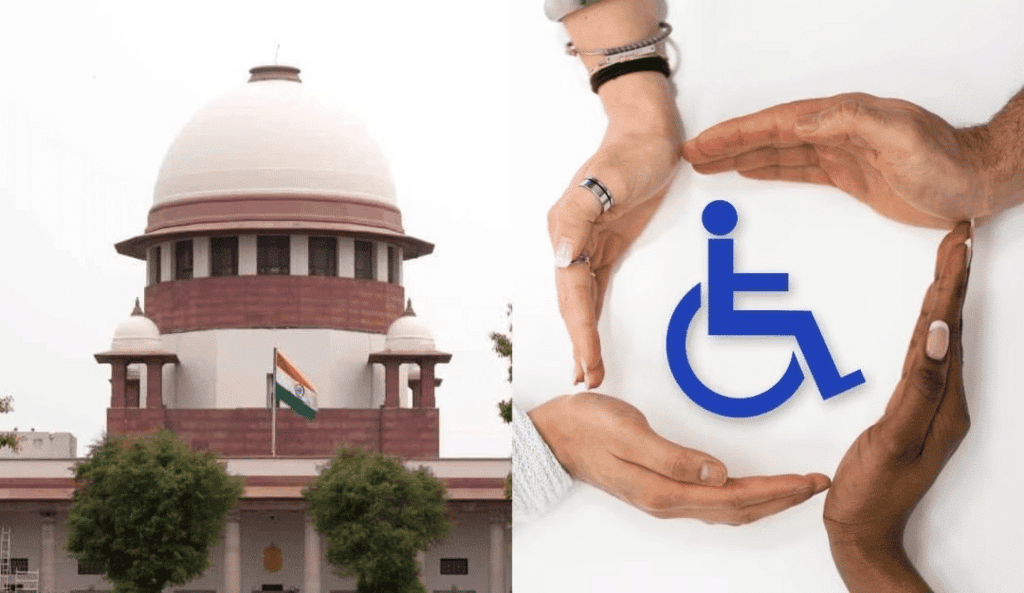 Why in News?
Why in News?
- The Supreme Court (SC) of India, in the case Amar Jain v. Union of India & Ors, 2025, ruled that inclusive digital access to e-governance and welfare systems is an integral part of the fundamental right to life and liberty. The court issued directives to enhance the accessibility of the Know Your Customer (KYC) process for persons with disabilities (PwDs), responding to petitions from individuals struggling with digital KYC due to their disabilities.
Key Takeaways
- The SC emphasized the need for digital KYC norms to accommodate individuals under the Rights of Persons with Disabilities Act, 2016.
- It mandated that the Reserve Bank of India (RBI) and other entities ensure accessibility in KYC processes.
- Departments are required to appoint nodal officers for compliance and conduct audits involving the visually impaired in the design phase of digital platforms.
Additional Details
- Digital KYC Revisions: The SC's ruling specifically addresses the needs of individuals with vision impairments and facial disfigurements, such as survivors of acid attacks, ensuring that KYC processes are accessible to them.
- Addressing the Digital Divide: The court noted the ongoing digital divide affecting not just the disabled but also rural communities, senior citizens, and economically weaker sections, making universal digital access a constitutional obligation under Articles 21, 14, 15, and 38.
- Key Hindrances: Challenges such as a significant digital literacy gap, weak enforcement of accessibility guidelines, and the scarcity of affordable assistive technologies hinder the digital empowerment of PwDs in India.
In conclusion, the Supreme Court has affirmed that digital access for PwDs is a fundamental right under Article 21. However, bridging the digital divide necessitates inclusive infrastructure and targeted digital literacy initiatives. India must honor its commitments under the UN Convention on the Rights of Persons with Disabilities (CRPD, 2006) to ensure equal digital participation for all.
Mains Question:
- Analyze the challenges faced by persons with disabilities in accessing e-governance services. Suggest necessary regulatory reforms to address these challenges.
India's Struggles with Supporting Deep-Tech Startups
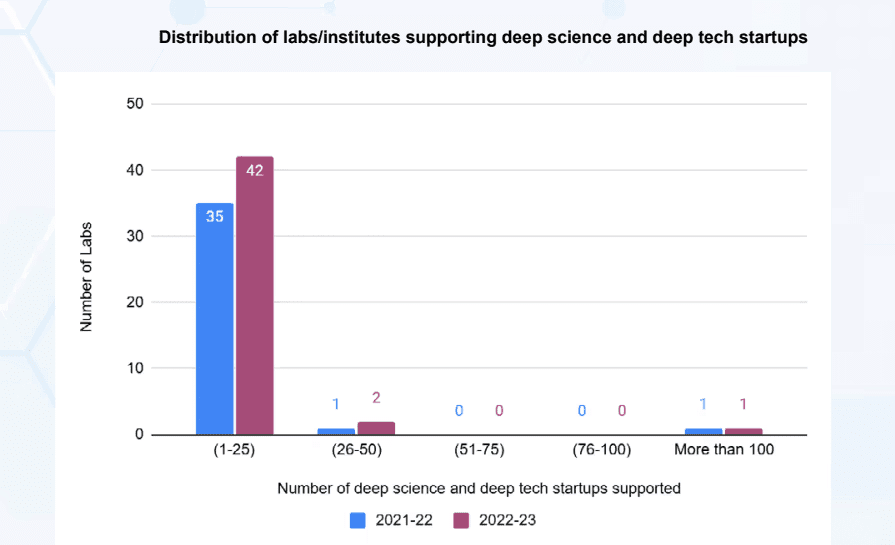
Why in News?
- A recent study commissioned by the Office of the Principal Scientific Advisor (PSA) has highlighted the challenges faced by India's public-funded Research and Development (R&D) ecosystem in supporting deep-tech startups.
Key Takeaways
- Only 1 in 4 public-funded R&D organizations provide incubation support for startups, with just 1 in 6 focusing on deep-tech startups.
- Collaboration with foreign industry partners is minimal, with only 15% of institutions engaging in such partnerships.
- Half of the labs do not permit access to external researchers or students, hindering knowledge-sharing.
- Budget allocation is skewed, with significant spending directed towards strategic sectors, limiting available resources for non-strategic sectors.
Additional Details
- Limited Support for Deep-Tech Start-Ups: The study indicates a lack of sufficient incubation support for startups, particularly in deep-tech sectors.
- External Collaboration Issues: About 50% of labs restrict access to external researchers, which limits innovation through cross-pollination of ideas.
- Budget Utilization: In 2020-21, the central government allocated Rs 55,685 crore for R&D, with only Rs 24,587 crore available for non-strategic sectors.
- Institutional Spending: Many labs, including CSIR and ICMR, reported spending below the median level for R&D activities.
Challenges Faced by Deep-Tech Startups
- Skewed Focus on Low-Tech Industries: Most Indian startups are concentrated in consumer-facing sectors such as food delivery and fintech, which are more appealing to investors than deep-tech.
- Underwhelming R&D Investment: India's gross expenditure on R&D is only 0.64% of GDP, significantly lower than countries like China.
- Lack of Risk-Tolerant Capital: Deep-tech ventures often require substantial upfront investment, which is hard to secure.
- Insufficient Institutional Collaboration: The absence of strong partnerships between industry and academia limits the practical application of research.
- Infrastructure Challenges: Many public-funded labs lack the necessary facilities to support high-tech startups.
- Brain Drain: Talented researchers are leaving India for better opportunities abroad, weakening the local ecosystem.
- Policy and Regulatory Complexity: The lack of a tailored compliance framework for deep-tech ventures hampers progress and discourages investment.
In conclusion, the study sheds light on the multifaceted challenges faced by deep-tech startups in India, calling for enhanced support from public-funded R&D organizations to foster innovation and improve the startup ecosystem.
Annual Survey of Services Sector Enterprises
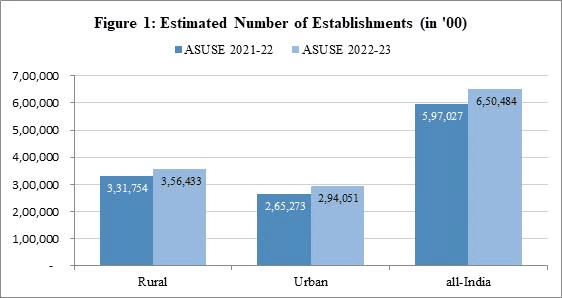 Why in News?
Why in News?
- The Ministry of Statistics and Programme Implementation has released findings from a pilot study focusing on India's incorporated service sector. This sector has been largely overlooked by existing surveys, such as the Annual Survey of Unincorporated Sector Enterprises. The study specifically targeted service sector enterprises registered under the Companies Act and Limited Liability Partnership Act.
Key Takeaways
- 82.4% of the surveyed enterprises were Private Limited Companies.
- Public Limited Companies and Limited Liability Partnerships each constituted 8% of the sample.
Importance of Services Sector Enterprises for India
- Contribution to GDP: As of FY 2024-25, the services sector accounted for approximately 55% of India's Gross Value Added (GVA), up from 50.6% in FY14, with a robust growth rate of 7.6% in FY24.
- Employment Generation: The sector employs around 30% of India's workforce, covering industries like information technology, finance, healthcare, education, tourism, and retail.
- Global Trade: India’s services exports reached USD 280.94 billion from April to December 2024, with telecommunications, computer, and information services contributing significantly, placing India as the 2nd-largest exporter in this category.
- Foreign Direct Investment (FDI): From April 2000 to December 2024, the services sector attracted USD 116.72 billion in FDI, making up about 16% of India's total FDI inflows during this timeframe.
- Integration with Other Sectors: The 'servicification' of industry, which integrates services such as design and logistics into manufacturing, has enhanced productivity.
- Critical for Urbanization & Digital India: The expansion of FinTech and digital payment systems is essential for initiatives like the Smart Cities Mission, which relies on services such as urban mobility and waste management.
Challenges Faced by the Services Sector in India
- Skill Gaps & Workforce Readiness: The Economic Survey 2023-24 indicates that only 51.25% of India’s youth are deemed employable, with a significant gap in the skills required by the industry. According to WEF, only 5% of India's workforce is considered formally skilled.
- Informal Employment Dominance: In 2017-18, approximately 78% of jobs in the services sector were informal, with gig workers lacking basic social security.
- Global Competition & Protectionism: The IT sector faces challenges from visa restrictions and increasing competition from countries like the Philippines and Vietnam.
- Infrastructure Gaps: Many larger firms have yet to adopt AI and ML technologies, which are critical for enhancing connectivity. Additionally, MSMEs in rural areas often lack access to basic digital tools.
- Post-Pandemic Vulnerabilities: Inbound tourism is still recovering from the pandemic, with foreign tourist arrivals only at 90% of 2019 levels in early 2024.
Strategies to Address Challenges in the Services Sector
- Upskilling: Expand the Skill India Digital initiative to certify skills in AI, cloud computing, and cybersecurity, alongside increasing vocational training opportunities.
- Strengthening Global Competitiveness: Negotiate free trade agreements (FTAs) with the EU, UK, and Australia to ease visa restrictions and promote Global Capability Centers.
- Digital Infrastructure and Cybersecurity: Invest in robust cybersecurity frameworks and promote secure cloud adoption, especially within financial institutions.
- Foster Growth in Tier-2 and Tier-3 Cities: NITI Aayog recommends decentralizing service-sector growth to boost infrastructure and digital connectivity in smaller cities.
In conclusion, the services sector is crucial to India's economy, significantly contributing to employment and global trade. However, challenges such as skill gaps, informal employment, and global competition hinder its growth. Addressing these issues through upskilling and infrastructure development, along with fostering growth in smaller cities, can enhance the sector's global competitiveness.
Question:
- What are the key challenges facing India's services sector despite its economic dominance, and how can it become more inclusive and resilient?
India’s Sacred Relic of Sakyamuni Buddha to Vietnam
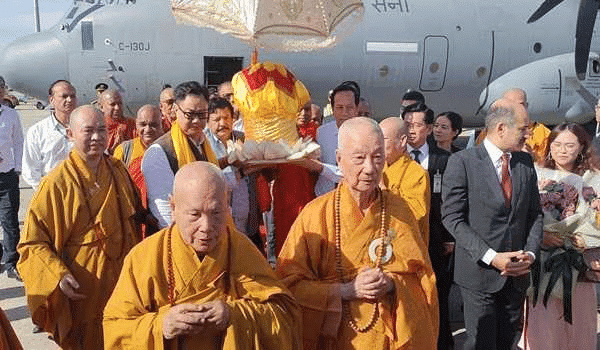 Why in News?
Why in News?
- India is sending the sacred relic of Sakyamuni Buddha from Sarnath to Vietnam for an international exposition in honor of the United Nations Day of Vesak on May 12, 2025. This event is organized by the Ministry of Culture and the International Buddhist Confederation (IBC). The occasion emphasizes the profound influence of Buddhism in Southeast Asia and highlights the crucial role ancient Indian rulers played in disseminating Buddhism across the region.
Key Takeaways
- The relic of Sakyamuni Buddha is a significant artifact, believed to be a physical relic of the Buddha, preserved since his Mahaparinirvana.
- The relic was excavated by the Archaeological Survey of India (ASI) from Nagarjuna Konda between 1927 and 1931.
- Indian emperors made considerable contributions to the spread of Buddhism in Southeast Asia, particularly during the Maurya and Gupta periods.
Additional Details
- Sarnath Relic: The relic was gifted to the Mahabodhi Society of India in 1932 and is currently enshrined at the Mulagandha Kuti Vihara in Sarnath, holding immense religious significance.
- Emperor Ashoka (268–232 BCE): Ashoka was instrumental in sending Buddhist missionaries to Southeast Asia, with his son Mahinda and daughter Sanghamitta establishing Buddhism in Sri Lanka, which laid the foundation for Theravāda Buddhism in the region.
- Gupta Period: The Gupta Empire (4th-6th century CE) actively promoted Mahayana Buddhism, which spread to Southeast Asia through trade and scholarly exchanges, leading to the establishment of renowned Buddhist universities like Nalanda.
- Borobudur: This massive Buddhist monument in Central Java, Indonesia, reflects Indian influence and was designated a UNESCO World Heritage site in 1991.
- Trade Routes: Indian rulers facilitated maritime trade, enhancing cultural and religious exchanges that allowed Buddhist ideas and practices to flourish across regions such as Sumatra and Java.
- Cultural Diplomacy: Indian epigraphy, Sanskrit inscriptions, and Buddhist art styles were adopted across Southeast Asia, influencing regions like Java, Cambodia, Thailand, and Myanmar.
- Angkor Wat: Originally dedicated to the Hindu god Vishnu, this largest religious monument in the world later became a Buddhist temple and was designated a UNESCO World Heritage Site in 1992.
- Bagan: Home to thousands of Buddhist temples and stupas, this UNESCO World Heritage Site in Myanmar showcases Theravāda Buddhist art and architecture, reflecting India's efforts in spreading Buddhism.
The sending of the Sakyamuni Buddha relic to Vietnam not only signifies a historical connection between India and Southeast Asia but also celebrates the enduring legacy of Buddhism and its cultural impact across the region.
Agent Orange
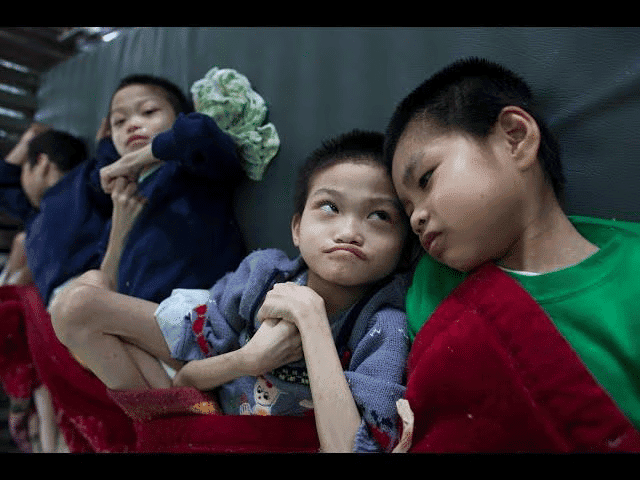 Why in News?
Why in News?
- April 30, 2025, marked the 50th anniversary of the Vietnam War's conclusion (1954–1975). However, millions of Vietnamese continue to suffer from the enduring effects of Agent Orange, a toxic chemical utilized by the US during the conflict.
Key Takeaways
- Agent Orange: A mixture of herbicides used to defoliate trees and shrubs, denying enemy troops vital cover.
- Composition: It contained two primary herbicides, 2,4-D and 2,4,5-T, along with the highly toxic contaminant dioxin.
- Dioxin: Has a half-life of up to 20 years in the human body and can persist in soil and water for up to 100 years, leading to long-term contamination.
Additional Details
- Health Impacts: The use of Agent Orange resulted in severe health issues, including birth defects, cancer, diabetes, and various neurological disorders.
- Areas affected by the chemical were rendered unsuitable for agriculture for many years, leading to significant harm to wildlife, soil quality, and local livelihoods, with lasting effects on ecosystems.
- Context of the Vietnam War: The Vietnam War was a conflict between communist North Vietnam, led by Ho Chi Minh, and the government of South Vietnam, which was supported by the US. This conflict was part of the broader Cold War between the US and the Soviet Union, with North Vietnam receiving backing from communist allies, including the Soviet Union and China.
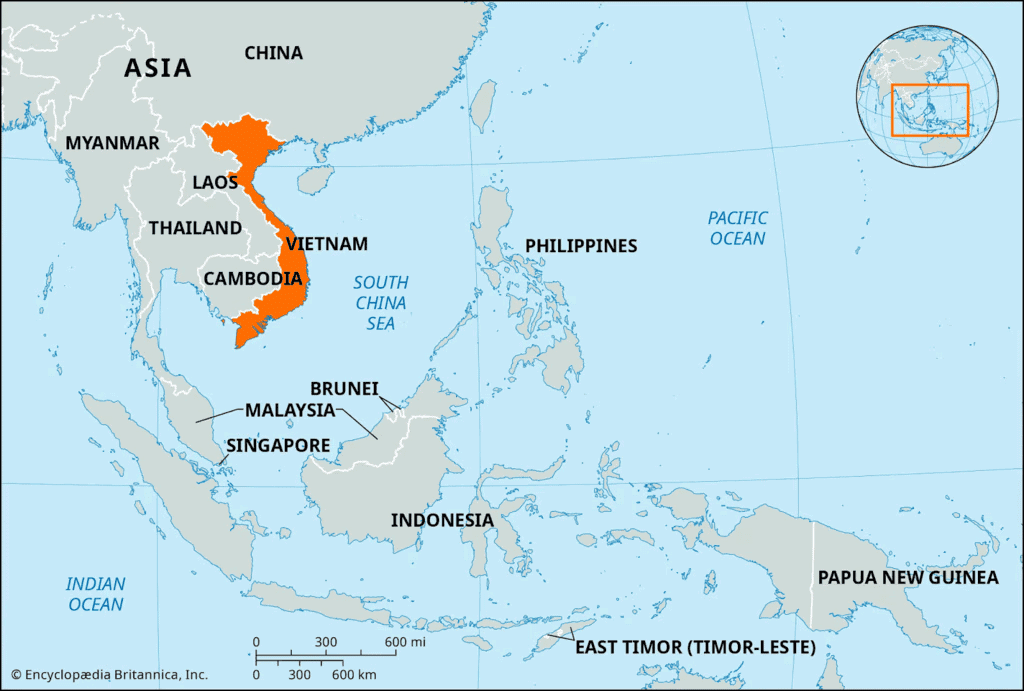
In conclusion, the legacy of Agent Orange continues to affect millions, highlighting the long-term consequences of chemical warfare in conflict zones and the importance of addressing such environmental and health issues comprehensively.
Transforming India’s Labour Force
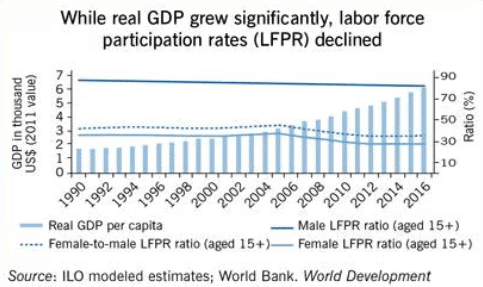
Why in News?
- On May 1st, the world commemorates International Labour Day to honour the dignity of work and workers’ rights. In India, while the day acknowledges workers' contributions, it also highlights the urgent need for stronger enforcement of labour laws to eradicate bonded and exploitative labour practices.
Key Takeaways
- 39 crore of India's 47 crore workforce is in the unorganised sector, lacking job security and social protection.
- Only 51.25% of graduates are deemed employable, indicating a significant skills gap.
- Female labour force participation has declined from 41.3% to 40.3% from 2023 to 2024.
- India's labour productivity is low, with GDP per working hour at USD 8, ranking 133rd globally.
Additional Details
- Widespread Informality: Approximately 39 crore workers are in the unorganised sector, indicating a lack of job security and social protection. In the organised sector, 9.8% of workers are informal, which further showcases the vulnerability of these workers.
- Low-Quality Jobs and Skill Gap: The International Labour Organisation's report highlights that low-quality jobs dominate the informal sector. The Economic Survey 2023-24 reveals that only 51.25% of graduates are employable, exacerbating the skills mismatch.
- Delayed Implementation of Labour Laws: The implementation of new Labour Codes has been stalled due to trade union objections and varying levels of state readiness.
- Gender Disparities: The female labour force participation rate dropped, while urban female unemployment is at 8.2%. There is a significant gap in employment opportunities for educated women.
- Low Labour Productivity: Despite long working hours, India has low productivity levels, which are essential for economic growth.
To enhance the productivity and inclusivity of its labour force, India must focus on:
- Enhancing Formalisation: Transitioning workers to formal employment through effective implementation of the Labour Codes and expanding social protection schemes.
- Boosting Skill Development: Improving vocational training quality and strengthening industry-academia linkages to prepare workers for future jobs.
- Revisiting Labour Codes: Promoting social dialogue and unionization to address challenges faced by informal sector workers.
- Promoting Gender Equality: Implementing policies that create safe work environments and support flexible work arrangements for women.
- Enhancing Health and Safety Standards: Ensuring strict enforcement of occupational health and safety standards, especially in high-risk sectors.
In conclusion, India must prioritize the creation of formal, secure, and meaningful employment opportunities. By investing in human capital, fostering gender equality, formalizing the workforce, and aligning skills with emerging industry demands, India can capitalize on its demographic dividend. Immediate and decisive action is vital for shaping a future-ready workforce.
Mains Question:
- Analyze the challenges faced by workers in India. What reforms can be implemented to ensure better protection for them under labour laws?
Debate Over Judicial Activism
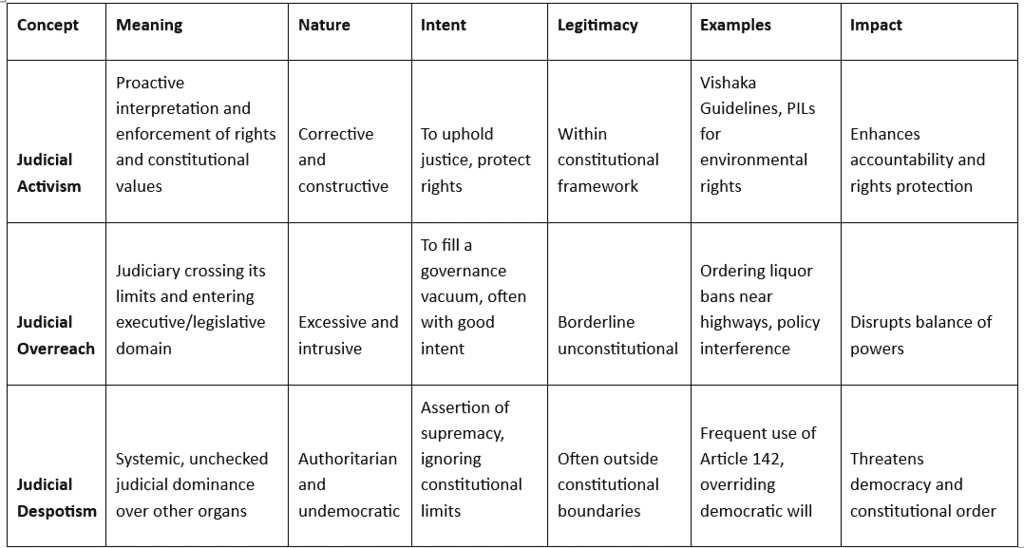
Why in News?
- India is currently experiencing a significant debate regarding the expanding influence of the judiciary. There are rising concerns about judicial despotism, which contrasts with the view that interventions by the Supreme Court are essential for maintaining constitutional values. Recent judgments have sparked discussions about the separation of powers and whether the judiciary has overstepped its constitutional boundaries.
Key Takeaways
- The debate centers on the judiciary's role and its potential overreach.
- Concerns about 'judicial despotism' versus the necessity of judicial intervention.
- Recent judgments raise questions about the separation of powers.
What is Judicial Despotism?
- Definition: Judicial despotism occurs when the judiciary, particularly higher courts, exercises excessive or unchecked power, often exceeding its constitutional authority and undermining the roles of the legislature and the executive.
- Key Features:
- Overreach into Other Organs: Courts making laws or intervening in administrative decisions beyond their constitutional limits.
- Frequent Use of Extraordinary Powers: Such as the frequent invocation of Article 142 without clear legal backing.
- Supersession of Democratic Will: Unelected judges overriding decisions made by democratically elected governments.
- Lack of Accountability: The higher judiciary has considerable power with minimal external checks, risking authoritarian tendencies.
Instances Related to Judicial Activism and Restraints
Instances Showing Judicial Activism:
- Broad Use of Article 142: The Supreme Court has been accused of issuing broad directives in cases such as mob lynching and the Babri Masjid issue.
- Directing states to keep liquor shops a minimum distance from national highways to reduce accidents.
- Issuing writs of mandamus against the President and Governors regarding state bill assent.
- Providing compensation for the victims of the Bhopal gas tragedy (1989).
- Establishing guidelines against sexual harassment in the workplace (1997).
- Granting permanent commissions to women officers in the armed forces (2024).
- Democratic Legitimacy: Judicial activism is seen as a means to uphold constitutional supremacy, as affirmed by the Supreme Court in I R Coelho v. State of Tamil Nadu (2007).
Instances Showing Judicial Restraint:
- Selective Intervention Only: The Supreme Court has generally upheld existing public policies, such as the demonetization, Rafale deal, and UAPA bail restrictions.
- Refusal to recognize same-sex marriage and dismissal of calls for a Pegasus probe.
- Delay in hearing critical cases related to the Citizenship (Amendment) Act and EVMs, raising concerns about judicial passivity.
- Acceptance of Sealed Evidence: Criticism for undermining transparency and due process in high-profile cases.
What is Judicial Review?
Definition: Judicial review is the power of constitutional courts (Supreme Court and High Courts) to assess the constitutionality of legislative enactments and executive actions.
Constitutional Provisions:
- The term “judicial review” is not explicitly mentioned in the Constitution but is implied in various articles.
- Article 13: Declares laws inconsistent with fundamental rights as void.
- Articles 32 and 226: Entrust the roles of protector and guarantor of rights to the Supreme Court and High Courts.
- Articles 131–136: Empower the Supreme Court to resolve disputes involving individuals, states, and the Union.
- Article 137: Grants the Supreme Court the authority to review its own judgments.
SC’s Stands on Judicial Review:
- In Kesavananda Bharati v. State of Kerala (1973), the SC confirmed that judicial review is a basic feature of the Constitution.
- In the Indira Gandhi v. Raj Narain (1975) case, it reinforced this principle.
- In the Minerva Mills Case (1980), the SC reiterated that limited government and constitutional supremacy are foundational, protected through judicial review.
Examples of Judicial Review:
- In Shreya Singhal v. Union of India (2015), the SC struck down Section 66A of the IT Act for violating freedom of speech under Article 19(1)(a).
- In the Supreme Court Advocates-on-Record Association v. Union of India (2015) (Fourth Judges Case), the SC invalidated the NJAC Act and the 99th Constitutional Amendment.
Way Forward
- Exercise Judicial Restraint: The judiciary should adhere to the principle of judicial restraint to avoid encroaching on legislative and executive roles.
- Promote Judicial Accountability: Implementing reforms such as reasoned judgments and performance audits can enhance accountability while preserving independence.
- Institutional Balance and Dialogue: All three branches—judiciary, legislature, and executive—should maintain their constitutional roles and foster dialogue to reduce conflicts.
- Ensuring Checks and Balances: Establish robust mechanisms for checks and balances among the branches to prevent any one institution from overstepping its authority while upholding constitutional supremacy.
This ongoing debate about judicial activism versus restraint emphasizes the need for a careful balance within the Indian constitutional framework to maintain the integrity of democracy and the rule of law.
Personality Rights
Why in News?
- The Madras High Court recently directed Meta and Telegram to eliminate fake accounts and channels that were misusing choreographer Anita R. Ratnam's images and deep fake audio in fraudulent investment schemes. This case highlights issues surrounding personality rights, particularly in the digital age.
Key Takeaways
- Personality rights protect an individual's public persona, including their name, voice, and mannerisms.
- These rights are integral to an individual’s privacy and property rights.
Additional Details
- Personality Rights:These rights provide individuals with control over the commercial use of their name, image, or likeness. They can be categorized into two main types:
- Right of Publicity: This protects an individual's image and likeness from unauthorized commercial exploitation, similar to trademark rights.
- Right to Privacy: This safeguards against the public representation of one's personality without consent.
- Under Article 21 of the Indian Constitution, individuals receive the closest legal protection for their personality rights, even though it is not explicitly stated.
- Key Related Provisions in India:
- Copyright Act, 1957: This act protects personality rights indirectly through provisions against passing off, which involves the deceptive use of a person’s name or likeness.
- Indian Trademarks Act, 1999: Section 14 prohibits the use of a living or deceased person's name or likeness without consent, particularly if it creates a false impression of connection.
- Information Technology Act, 2000: Section 66C addresses identity theft, penalizing the fraudulent use of someone else's electronic signature or identification.
- Related Key Judgments:
- Krishna Kishore Singh vs. Sarla A. Saraogi Case, 2021: The Supreme Court ruled that rights to privacy and publicity are not inheritable and cease upon an individual’s death.
- Justice KS Puttaswamy vs. Union of India Case, 2017: This case affirmed the right to life but noted that it can be restricted for legitimate state aims and must be proportionate.
- Shivaji Rao Gaikwad vs. Varsha Production Case, 2015: The Madras High Court recognized personality rights, affirming their importance despite the absence of a specific statutory definition in India.
- Arun Jaitley vs. Network Solutions Private Limited Case, 2011: The Delhi High Court acknowledged that an individual’s fame is as significant online as it is offline.
- M. Entertainment Pvt. Ltd. vs. Baby Gift House Case, 2010: The court ruled in favor of D.M. Entertainment Pvt. Ltd., affirming the commercial right to control the use of a public image.
In summary, personality rights serve as crucial legal protections for individuals against the unauthorized use of their persona, particularly in the context of evolving digital platforms. The recent court rulings underscore the importance of these rights in safeguarding personal identities and reputations.
|
287 docs|142 tests
|
FAQs on Weekly Current Affairs (1st to 7th May 2025) - 1 - Weekly Current Affairs - UPSC
| 1. What was the impact of the Supreme Court ruling on digital access for persons with disabilities in India? |  |
| 2. How is India supporting deep-tech startups amid challenges? |  |
| 3. What insights does the Annual Survey of Services Sector Enterprises provide? |  |
| 4. What is the significance of India's sacred relic of Sakyamuni Buddha being sent to Vietnam? |  |
| 5. What are the key issues in the debate over judicial activism in India? |  |





















